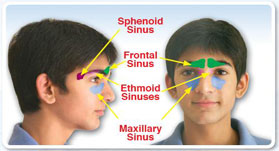I Have Sinus Issues, But I Don’t Even Know What a Sinus Is
So you’re constantly hearing the word “sinus”: sinus rinse, sinus congestion, sinus infection, sinusitis…but have you stopped to think, ‘What exactly are the sinuses?’ Here is a rundown of the anatomy of your sinuses and how they function.
The nose is the entryway towards the sinuses. The first passageway into your nose and towards your sinuses begins with the nostrils. This is the way in which air and other particles enter. The nose is divided in half by the partition between your nostrils, called the septum. (Some people have a deviated septum, but this is a topic for another day.) Once inside the nose, you have the nasal cavities, which contain the entrance to your sinuses.
Click here to view our Sinus Anatomy & Sinus Allergy App
Everyone has four pairs of sinuses (although for unknown reasons, 10% of people never develop the frontal sinuses, which has no effect on their health). The maxillary sinuses are the first pair of sinuses in the nasal cavities. They are located behind your cheekbones, going from beneath the eyes to the upper teeth. These are the sinuses that are responsible for causing tooth pain when you are experiencing pressure in your sinuses.
Continuing through the nasal cavity, the ethmoid sinuses are the next pair to come. These are located in between your eyes and are especially important for healthy sinus function. The frontal and maxillary sinuses both depend on draining through the ethmoid sinuses first before entering the nose, so the ethmoid sinuses must be functioning to avoid blockages in other sinuses. The next pair of sinuses is the frontal sinuses, which are behind your forehead. Lastly, you have the sphenoid sinuses behind your nose. They are located deep within the skull where your brain and eyes meet.

In order to get into the sinuses, mucus must travel through the ostia. The ostia stay open for free entry of air and mucus, but can become blocked when infection or allergies cause inflammation. After the ostia, mucus must also get through the narrow passageway called the ostiomeatal complex (OMC) before finally entering the sinus cavity. When the OMC becomes blocked, air and mucus are unable to enter the sinuses.
Now that you know the different sinuses and parts of the nose and where they are located, let’s discuss what’s inside the sinus cavities. The walls of the sinuses are covered with mucus-secreting glands that are responsible for producing mucus. Mucus lines the inside of the sinuses and is extremely important for trapping bacteria and foreign particles that have entered through your nostrils. The lining of the sinuses also contains cilia—tiny hairs—that move mucus and particles into the nose to be drained. Clearly, mucus and cilia are both vital for staying healthy and avoiding the development of infection from unwanted elements.
In case you’re curious just how much mucus you produce ever day, individuals with healthy sinuses produce about eight ounces—that’s one cup! Healthy mucus is thin and watery, which is why you don’t seem to notice that you’re constantly swallowing it; however, mucus becomes thicker and more unpleasant when you are dehydrated or sick.
Hopefully this gives you a better idea of what may be going on the next time you have a sinus infection. If you would like information on the sinuses and dealing with sinus issues, the Harvard Medical School Guide to Healing Your Sinuses, written by Dr. Ralph Metson with Steven N. Mardon is a great and easy-to-read source.
Please submit your comments and any suggestions or requests for future topics below!
(11935)
Very clear and useful.An article on how to avoid sinus trouble during and after longhaul flights would be particularly helpful.
Thanks. Good to know!
Dear readers,
I’m glad you’ve found this blog helpful 🙂 I am no ENT, however, so I have to attribute my basic run down of the sinuses to the above mentioned book. Thanks for your support!
Very well written, and easy to understand! Thanks, Alisha :o)
Very nice description of sinus anatomy. Absolutely love this post.